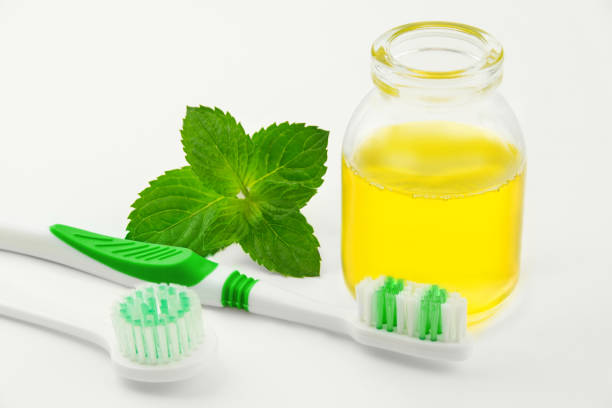Oil pulling and its beneficial effects on dental and oral health. What is it and how does it work? We have all the important facts about the oil pulling effect and possible areas of application.
Drawing with oil originally comes from Ayurvedic teachings and is firmly anchored in a healthy daily routine. It is said to have a positive effect on dental health and detoxify the body. Consequently, it is said to alleviate many health ailments.
What is oil pulling?

Oil pulling is a traditional form of detoxification from Ayurveda. Oil pulling has been used here for thousands of years. And is considered an important part of holistic healing treatment. In addition, this oil cure is firmly anchored in the recommended and healthy daily routine of Indian medicine. Consequently, after getting up, two to three glasses of warm water are drunk and meditated. This is followed by brushing your teeth and pulling with the oil. Also, note our tips on deacidifying the body.
The positive effects of oil pulling
Oil pulling has a positive effect on dental and oral health. Because the application has a caring and antimicrobial effect. Consequently, bad bacteria in the mouth should be fought and ensure healthy teeth. It is also said to help the body with detoxification. And as a result, other health complaints and diseases, such as migraines or heart problems, are also alleviated. However, the spirits also differ here. While many see the positive effects on dental health and other diseases as proven, others lack the scientific evidence.
Which oil can I use?
Oil pulling, but which oil? Lime-pressed sesame oil or sunflower oil is suitable for Ayurvedic use. You can also use virgin coconut oil. Because these were used for most of the studies and showed an antibacterial effect. Anti-inflammatory properties have also been demonstrated in sesame and coconut oil. You should always make sure that the oils are organic. Other oils also show antibacterial effects and could be used for oil treatment.
What does the oil cure help?
As already mentioned, the oil treatment has a positive effect on dental and oral health. In addition, Ayurvedic teachings assume that it can also heal other health problems. In the following, we have collected the most important areas of application against which oil pulling can help. In addition, note our other tips for proper oral hygiene.
1) Oil pulling reduces plaque
Daily oil pulling shows a reduction in dental plaque. Since plaque can damage teeth and cause tartar or periodontal disease, you should remove plaque effectively. An effective home remedy for the plaque is pulling with oil. Therefore, you should incorporate this into your dental care routine.
2) To prevent tooth decay
A 2008 study shows that oil pulling can reduce tooth decay-causing bacteria in the mouth. Thus, the application is a good way to prevent tooth decay. You should also brush your teeth properly and take the time for adequate dental care. Consequently, you can get healthy and white teeth.
3) Oil pulling ensures healthy gums
If you have problems with bleeding gums and bad gums, the oil pulling application may be just what you need. Here, too, a study shows the improvement in gum health through oil pulling. For the application to work, you should draw the oil in your mouth for at least 20 minutes. Also, note our other home remedies for gingivitis for quick relief of the pain.
4) As a home remedy for bad breath
Bad breath is an extremely unpleasant thing. If you suffer from bad breath, pulling oil every day can help you get rid of bad breath effectively. Because removing the coating on the tongue eliminates bad smells. And the antibacterial effect of the oil pulling application also has a positive effect on the oral flora. You can get rid of the bad bacteria that are responsible for bad breath.
5) Oil pulling for mouth sores

There is also a reduction in inflammation in the mouth. You should take advantage of the antibacterial and anti-inflammatory effects of coconut oil in particular. Consequently, you can quickly get rid of the pain in the mouth. And with daily use, you can also prevent sores in the mouth. Also, read our useful home remedies for mouth sores.
6) Get rid of dry mouth with oil pulling
Dry mouth leads to swallowing difficulties and dry mucous membranes. And that can be very uncomfortable. Therefore, suitable remedies against dry mouth are needed. Oil pulling for teeth has also been proven effective for a dry mouth. Consequently, you can counteract a dry mouth by infusing a tablespoon of coconut oil in your mouth for about 20 minutes.


